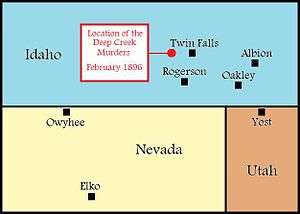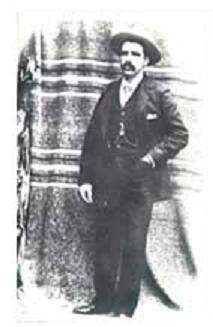Deep Creek murders
The Deep Creek murders was the culmination of a minor sheep war in the borderlands of Idaho and Nevada. On or about February 4, 1896, two Mormon sheepherders were killed by an unknown assailant while they were camping along a creek in what was then part of Cassia County, Idaho. The gunfighter Diamondfield Jack Davis and his associate, Jack Gleason, were arrested, but the latter was released and Diamondfield Jack was pardoned in 1902, after serving six years in jail. The deaths of the two sheepherders are the only confirmed killings attributed to the conflict, however, according to author J. Anthony Lukas, the incident was "one of the last great confrontations in the sheep and cattle wars."[1][2][3]
 | |
| Date | February 4, 1896 |
|---|---|
| Location | Twin Falls County, Idaho, USA |
| Deaths | 2 |
Background
The leading figure in the conflict was a prominent cattleman named John Sparks. Sparks came to southern Idaho from Nevada in the early 1870s. A former Texas Ranger, Sparks was one of the first people to explore what was still a very isolated wilderness. Sparks later became the partner of another rancher named Jasper Harrell and eventually they established series of ranches on both sides of the Idaho-Nevada border. By the summer of 1895, Sparks was the most powerful cattleman in Idaho. He controlled huge stretches of territory, though his ownership was still mostly unofficial. Sparks felt that because he had used the lands for so many years without opposition, there was no way he was going to let the hated sheep destroy it. That year a wave of Mormons and Basques left Utah and headed north for Nevada and Idaho. Sheepherding was very popular in Utah so, when they left, the Mormons and Basques brought their sheep with them. Grazing sheep often proved to be very destructive to the environment, which cattlemen relied on for their livelihood. Sheepmen were known for letting their animals strip a pastureland of all vegetation, leaving it useless for the cattlemen who needed to use it next. Sheep also polluted water sources to where cattle would not use them. For this, cowboys referred to sheep as "desert maggots," or "hoofed locusts." Both of these factors prompted many cattlemen to begin building fences, or establishing deadlines, a type of boundary which sheep were not permitted to cross. John Sparks ran one of these deadlines through Elko County, Nevada and Cassia County, Idaho. Sheepmen were not allowed to go either west or south of the line. Sparks also hired several gunfighters as range detectives to "keep the sheep back."[1][4][5][6][7]
Usually, the range detectives would simply threaten the herders and occasionally shoot up a flock, their only orders were to "shoot to wound", but only "if necessary." Diamondfield Jack Davis was the most famous of the detectives and he was known for being exceptionally bloodthirsty. He led many of the raids in northern Nevada and even poisoned water sources with salt, making them unusable for either faction. During one of his forays, Diamondfield Jack wounded a sheepherder, named Bill Tolman, which was how the war began. Additional raids followed, but actual combat was limited because most of the sheepherders were too frightened to resist. One man was so afraid that he camped in the middle of his flock, hoping to evade patrolling cowboys. One night, about thirty of his sheep were shot dead around him, but he escaped unharmed.[8][9][10][11][12]
The murders

The most remembered shooting incident to take place during the war happened at a place now known as Deadline Ridge. Late in 1895, two Mormon sheepherders named Daniel Cummings and John Wilson crossed the deadline in Cassia County to graze on the Deep Creek Range. A few weeks later, on about February 19, 1896, their bodies were discovered by another shepherd, Edgar "Ted" Severe. Both men died of gunshot wounds and the coroner who examined the deceased said they had been killed on February 4, 1896, or the day after. This was further substantiated by a lumberjack who delivered a load of wood to the sheepherders' camp on February 4. When police investigated the crime scene, they found that only a small portion of the wood had been used for a campfire so it seemed as though the murderer arrived shortly after the delivery and made his attack that night, or early the next morning. Diamondfield Jack was the prime suspect, mostly because in the past he said he would kill the next sheepherders who crossed the deadline in Cassia County. There was also evidence that Diamondfield had bragged about killing the two sheepherders when he turned up in Nevada sometime shortly after the murders.[1][6][7]
Aftermath
Diamondfield Jack was brought back to Albion for his trial. He was defended by James H. Hawley, a future Idaho senator, but was quickly sentenced to hang on June 4, 1897, due to the efforts of William Edgar Borah, an attorney appointed by the Elko County Sheepmen's Association. However, while waiting for execution, two men named James Bower and Jeff Gray confessed to the murders. Although the two men were acquitted, their confession raised concern as to whether Diamonfield was truly responsible for the crime. For this, Jack's case was reprieved on the day before his execution was to take place. Jack remained in the Albion jail for two more years, waiting to be executed, but, on February 24, 1899, the Idaho legislature approved an act which ruled that all future executions must take place in the state penitentiary at Boise. As result, Jack arrived at the Boise Depot on February 27, 1899. He remained there until December, when the Supreme Court of Idaho decided that Jack should be sent back to Cassia County as a county prisoner, rather than a state prisoner. Jack was sentenced to die again, on July 3, 1901, but by that time, the public had become well aware of the situation and most thought he was innocent. Because of the public support and the influence of John Sparks, Jack's execution date was extended to July 17. He again escaped hanging though. On July 16, the Board of Pardons had Jack's sentence commuted to life in prison and he was sent back to Boise. This was largely because of Sparks, who, by that time, had been elected the governor of Nevada. When he was finally released from prison, in December 1902, Jack became a prospector and became wealthy digging for gold and establishing mining towns around Tonopah and Goldfield, Nevada. He died in 1949 after being hit by a taxi.[1][9][13][14][15]
Today there are several markers in Nevada and Idaho associated with Diamondfield Jack or the murder case he was involved with. Re-enactments of the murder are also held each year in parts of Nevada and Idaho. The graves of Daniel Cummings and John Wilson can still be seen in the Oakley, Idaho cemetery.[16][17][18][19]
In 1907, the area where the murders occurred became part of Twin Falls County.
See also
- List of feuds in the United States
References
- Lukas, J. Anthony (1998). Big Trouble: A Murder in a Small Western Town Sets Off a Struggle for the Soul of America. Simon and Schuster. pp. 288–289. ISBN 978-0-684-84617-0.
- Myers, John M. (1997). The Westerners: A Roundup of Pioneer Reminiscences. University of Nebraska Press. ISBN 978-0-8032-8236-0.
- "More Idaho Treasues Just Waiting To Be Found". Retrieved June 27, 2012.
- "History of Idaho - Page 4". 2005. Archived from the original on August 27, 2012. Retrieved June 27, 2012.
- "isu.edu: Immigration & Emigration". Retrieved June 27, 2012.
- "City of Rocks NR: Historical Resources Study (Historical Development)". Archived from the original on September 4, 2007. Retrieved June 27, 2012.
- Young, James A.; B. Abbott Sparks (2002). Cattle in the cold desert. University of Nevada Press. ISBN 978-0-87417-503-5.
- "The True Story of Wilson and Cummings Murder" (PDF). Archived from the original (PDF) on January 13, 2014. Retrieved June 27, 2012.
- "Diamondfield Jack". Archived from the original on January 13, 2014. Retrieved June 27, 2012.
- "idaho.gov: Idaho State Historical Society Reference Series" (PDF). December 1981. Retrieved June 27, 2012.
- Gottberg, John (2008). Compass American Guides: Idaho, 3rd Edition. Random House Digital, Inc. ISBN 978-1-4000-0741-7.
- Roger Butterfield. "Elko County". Life Magazine. Time Inc. (April 18, 1949).
- "Nevada's Latest Bonanza (1904)". James F. O'Brien. August 1904. Archived from the original on October 13, 2012. Retrieved June 27, 2012.
- "gamemasteronline.com: Gamblers of the Wild West by Bill Kelly". Bill Kelly. Archived from the original on January 13, 2014. Retrieved June 27, 2012.
- Fanselow, Julie (2008). Idaho Off the Beaten Path, 7th. Globe Pequot. ISBN 978-0-7627-4781-8.
- "Diamondfield Jack Marker". Retrieved June 27, 2012.
- "nevada-landmarks.com: Diamondfield Jack Davis". Archived from the original on January 13, 2014. Retrieved June 27, 2012.
- "Frank Fara ~ Songs of the Untamed West". Retrieved June 27, 2012.
- "Victims of the bloody war between the Cattle and Sheep men in Cassia County". Retrieved June 27, 2012.